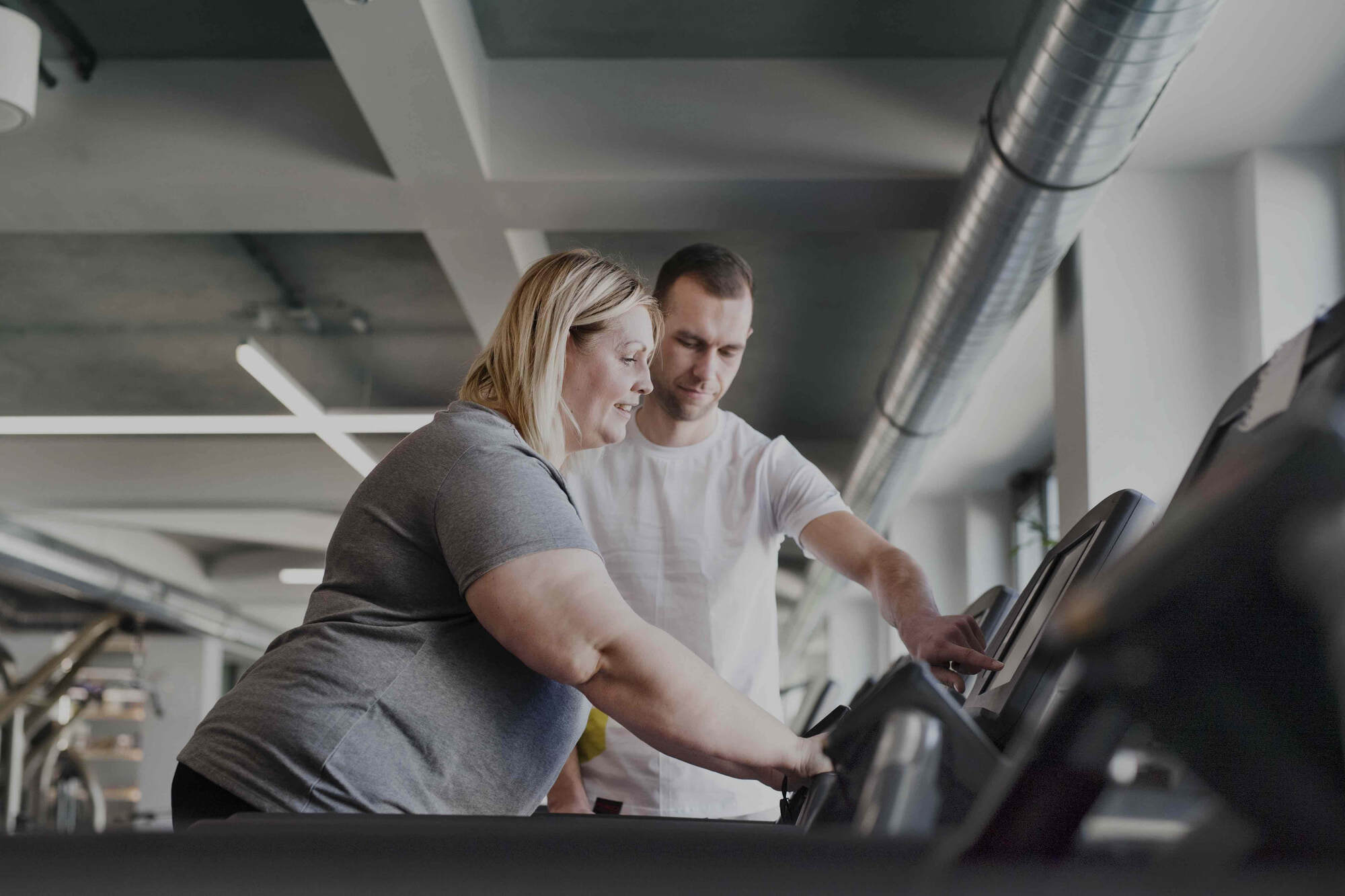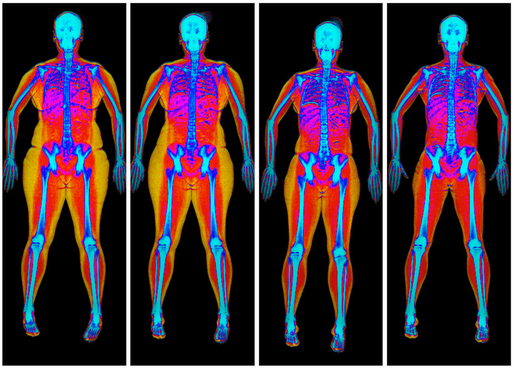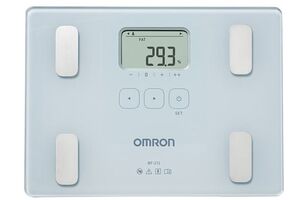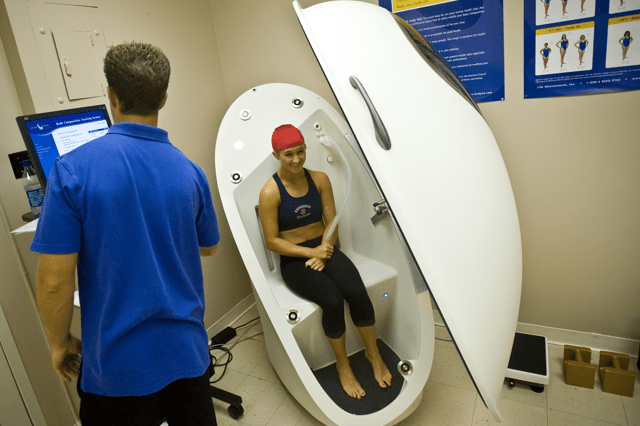
HOW TO MEASURE YOUR
BODY COMPOSITION
Body Composition Test
If you’ve found this web page, then you probably have some desire to look better naked or improve your performance in a particular sport or activity. To do either of these requires you to understand and change your body composition. For most people that will require a decrease in the amount of body fat and an increase in muscle mass.
What is body composition testing?
A test to establish your body composition is a means to quantify how much of your total body mass is fat, and how much is non-fat (known as fat-free mass). Depending on the method used to measure body composition, the fat-free mass may be broken down further into the components of, say, fat-free soft tissue (muscles and organs) and bone mass.
A test for body composition goes beyond just weighing yourself on a set of bathroom scales or knowing your Body Mass Index (BMI), which is how much you weigh compared to your height. That’s because weight tell us nothing about the composition of the object on the scale – a kilogram of feathers weighs the same as a kilogram of lead.
How do you measure body composition?
There are quite a few methods for measuring body composition and they all have their own pros and cons, particularly in the areas of accessibility, cost, accuracy and consistency. Here are five methods you’re most likely to come across.
DEXA Scan
DEXA or DXA (dual-energy X-ray absorptiometry) is universally regarded as the gold standard for measuring body composition and until recently was the preserve of sports science research labs and elite athletes. It uses a very low dose of radiation to accurately measure fat mass, lean mass and bone mass. Bodyscan is the UK’s biggest DEXA body scan company.
Advantages
Accuracy, precision and consistency. Many people talk (understandably) about accuracy but for most people consistency is actually more important. You want to be sure that a change in body fat is faithfully recorded and, conversely, that a reported change in your body composition is real. DEXA wins hands down when it comes to consistency.
Disadvantages
A private DEXA scan for body composition analysis can be expensive but consider that you’re being measured on a £100,000 medical-grade machine. The report is heavy on numbers and includes a lot of information and data you’ll be discovering for the first time, so make sure your scan includes a detailed consultation with someone who knows what they’re talking about and has a mass of data to put your results into perspective.

Skinfold calipers

Calipers are the tools most often wielded by personal trainers and, like PTs themselves, can span in sophistication from cheap and nasty to expensive and professional. They work simply by measuring the thickness of folds of skin in different parts of the body and then plugging these measurements into one of many formulas to establish an overall body fat percentage.
Advantages
Cheap and accessible. You can buy a simple set of calipers online for less than £10 and attempt to do it yourself. Calipers are fine for simply tracking a trend (if the skinfolds are getting thicker you are putting on fat).
Disadvantages
Because calipers rely completely on the person using them, the results are highly subject to human error and can be wildly inconsistent. Measurements taken just a centimetre away from the designated spot can render the result next to meaningless. Caliper users should be qualified through the International Society for the Advancement of Kinanthropometry (ISAK) and most users are not. Also, if you have an unusual body fat distribution, the inputs from the different pinch-points will be unreliable.
Bio-impedance Analysis (BIA)

The name of the technology may be less familiar than the devices themselves and you may well own one in the form of a pair of ‘fat scales’ bought from, say, Argos or a department store, or use a slightly more sophisticated set-up at your local gym. Bio-impedance devices work by measuring your body’s resistance to a small electrical current and then using that as a proxy for body fat.
Advantages
Cheap, easy to use. The latest models will sync with an app on your smartphone so you can easily and regularly track movements in body fat.
Disadvantages
Whilst very widely used, bio-impedance is unreliable and inconsistent because its result depends upon your level of hydration. This changes naturally throughout the day and after exercise. The algorithms used to arrive at body fat percentage are based on populations against which you may be an outlier due to your age, sex and ethnicity. The electric current produced by most BIA devices goes up one leg and down the other, ignoring the upper body completely.
Hydrostatic weighing
Underwater weighing is based on the Archimedes Principle (Eureka!), which states that the volume of liquid displaced by an object is the same as the volume of the object itself. If that liquid is water (of which one litre conveniently weighs one kilogram) then knowing your weight underwater and on land will enable us to work out your body’s volume and density and, from there, your body fat percentage.
Advantages
Before DEXA, hydrostatic weighing was considered the gold standard for measuring body composition and, like DEXA, establishes density in order to arrive at fat and fat-free mass. (Because fat is less dense than muscle and bone, a person with high body fat will weigh less underwater than someone with less fat and more muscle.)
Disadvantages
A hydrostatic weighing set-up is a very specialised affair (a big tank with a submersible, tubular chair suspended above it), so they’re hard to find. Universities or laboratories that still have one probably measure only athletes and teams, not individuals. The procedure is not simple (holding your exhaled breath underwater) and prone to errors, which is why three measurements are usually done and the average taken.
BodPod (air displacement plethysmography, ADP)

BodPod is a brand name and the air equivalent of underwater weighing – rather than displacing water in a tank, you sit in a small capsule of known volume and displace air.
Advantages
BodPod may be easier to find than hydrostatic weighing and cheaper as a result but still likely to be at a university rather than a commercial offering. Unlike hydrostatic weighing, there’s no water and it’s a quicker, less involved procedure, but you’ll still have to wear your budgie smugglers or swimsuit.
Disadvantages
If you’re claustrophobic, you might find sitting inside the sealed pod uncomfortable. BodPod has been found to be inconsistent between measurements, and affected by facial hair, your body temperature/moisture and the fit of your swimsuit, making it a poor choice for tracking changes in your body composition over time.
Conclusion
If you’re the type of person who wants a measurement or analysis of your body composition at any given moment, jumping on your own set of bio-impedance ‘fat scales’ or seeing how much belly fat you can pinch with your own pair of calipers may be the way to go. Cheap and easy, you’ll pick up a trend over the long term, even if volatile from day to day.
For something more lab-based, you could try the BodPod, but the variation between measurements taken weeks or months apart could mean that changes in your fat and lean mass are not recorded, or the lack of precision suggests you have lost or gained body fat when you haven’t.
Underwater weighing, if you can find it, is the old gold standard, though the rigmarole and its scarcity might mean you test only rarely and you miss changes in (and the need to tweak) your more frequent diet and training cycles.
Also, all the above methods strive to give you a single number known as your body fat percentage which, despite its universal acclaim, is actually a flawed number – it’s affected by muscle as well as fat, and it doesn’t allow for height. See this video.
A body scan, while perhaps the most expensive of the methods discussed, is not cheap for a reason. It gives you an accurate, highly consistent, method that can be taken at regular (8-12 week) intervals to precisely track changes in body composition over time. And the comprehensive amount of data, if delivered by a skilled consultant, will enable you to set specific targets for fat loss and muscle gain and a realistic time frame in which to achieve them.
Choose a DEXA scan for your Body Composition test!
Bodyscan is the UK’s only company dedicated to measuring body composition with DEXA technology. Since 2015, we have performed over 21,000 scans, accumulating Europe’s biggest DEXA database of men and women of all body types.
For 10% off your first DEXA Baseline Scan with face-to-face consultation, click here.

Please check our FAQs first!
Our FAQs give info on Prices, Making a Booking, Having the Scan and Prepaid Packages.


